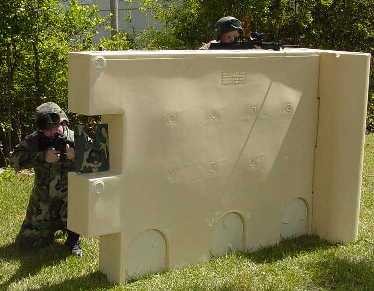 S.L.A. MARSHALL (SLAM) WEAPONS SHIELD FOR THE SOLDIER: First-Person Shooter--NOT Victim
S.L.A. MARSHALL (SLAM) WEAPONS SHIELD FOR THE SOLDIER: First-Person Shooter--NOT Victim
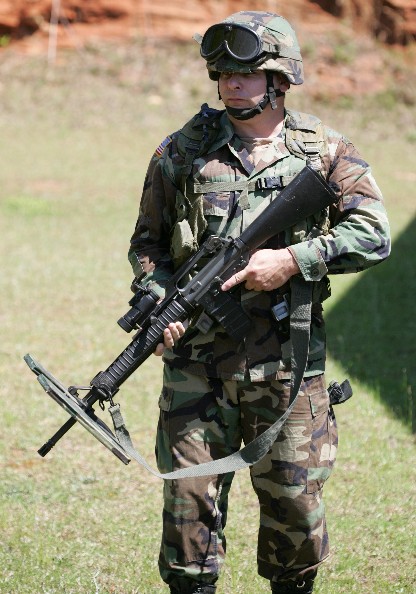
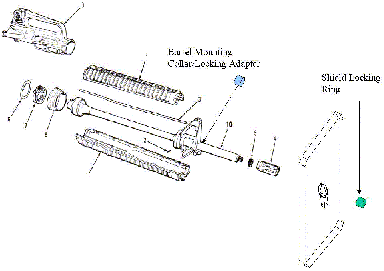
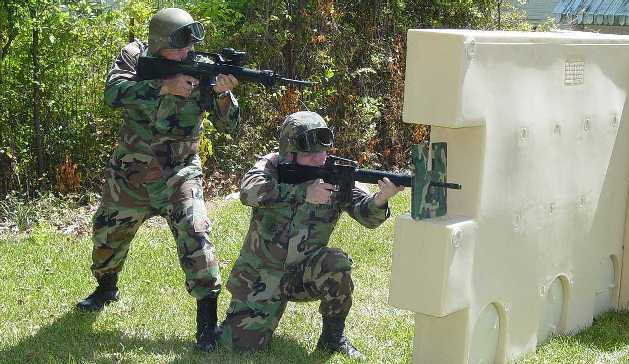
Excellent Photos by Hans Halberstadt and Jim LaBeau
"....plainly apparent from the end of 1914 onwards, the next steps in thought will be equally simple. Something must be discovered which....{will} make it unnecessary for Soldiers to bare their breasts to the machinegun hail.....The remedy when stated appeared to be so simple that it was for months or even years scouted and disregarded by many of the leading men in the great fighting professions.
Reduced to its elements, it consisted in interposing a thin plate of steel between the...body of a man and the approaching bullet".
---Sir Winston Churchill, The World Crisis quoted in the book, Taming the Landmine by Peter Stiff, pages 11-12
Many people play Third and First Person Shooter (FPS) video games where the penalty for being "killed" is just a temporary button push and you come back to life. Real-life infantry, Commandos, Paratroopers and Special Operators actually can't afford to even be hit ONCE. In real life (IRL) once a dismounted unit starts taking hits and suffers casualties it could lose the momentum of its attack or worse be forced to "circle-the-wagons" and become pinned down begging for rescue. It's long overdue we end this WW1 deadlock by employing tanks and gunshields as Churchill invented. We cannot armor an entire man's body to make him bullet-proof but that's why we need tracked, armored tanks to be able to advance in the face of enemy fire. What we CAN do is give him a MINI-SHIELD that he carries with him on the end of his weapon that he strives to stay behind as he does fire & maneuver or fire & movement.

In the 1987 James Bond movie, "The Living Daylights" loosely based on Royal Navy Intelligence Commander Ian Fleming book by the same name, arms smuggler Brad Whitaker uses an assault rifle with a clear GUNSHIELD to combat our hero played by Timothy Dalton. Bond's small caliber 7.65mm PISTOL shots bounce off Whitaker's clear gunshield to no effect (see photo at top right of this web page) and this is realistically achievable with current see-through materials but not possible for an under 3 pound gunshield. U.S. Army Natick Lab's approach is to come up with a clear face shield at the helmet, but we believe this is waiting too long to try to stop high-velocity projectiles and with weak clear materials. We propose a lighter, opaque material for a gunshield so it can stop a 7.62mm x 39mm RIFLE bullet--the more likely enemy projectiles that will be encountered in battle. And we have MANY battles where men have been killed and wounded at the exposed area under the helmet.
Somalia. 1993.
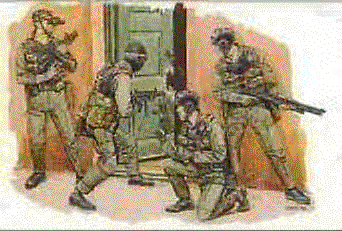
U.S. Army Rangers and SFOD-Delta troops are pinned down by enemy fire from superior numbers of enemy with automatic weapons and RPGs.
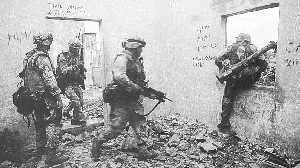
Their only "shield" is their own small-arms fire to keep the mobs away.
But, they are running low on ammunition...
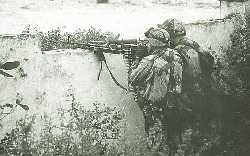
Soldiers protecting the UH-60 Blackhawk helicopter crash site run out of ammunition and are over-run, later being awarded the Medal of Honor, Master Sergeants Shughart, and Gordon for saving the life of the downed Blackhawk pilot, Warrant Officer Michael Durant there.
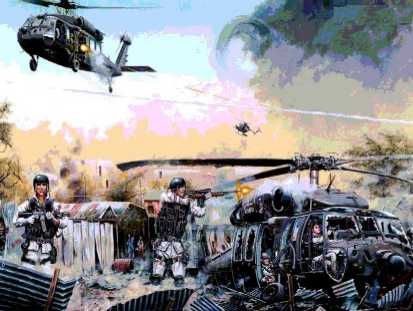
Everywhere else, Soldiers returning fire are hit as they peer out from cover to keep their shielding fire up. Several are hit as they expose themselves to shield their brothers from the enemy. 17-19 men die and many are maimed in this firefight more fierce than any since Vietnam.
Jim Dunnigan's Strategypage reports:
http://www.strategypage.com/search.asp?target=d:\inetpub\strategypageroot\fyeo\howtomakewar\docs\htinf.htm&search=molle
"May 16, 2003: More medical reports indicate that the new Interceptor protective vest was, indeed, bullet proof. Only nine percent of the combat wounds to 118 Army casualties were in the trunk, and these were either by larger caliber weapons or shots that came in at odd angles and got around the Interceptor (like via an armpit.) Autopsies of 154 dead Soldiers showed that the single most common area hit was the head (neck and face, the rest is well protected by the Kevlar helmet.) The next largest category is multiple wounds, including ones that sever major [arteries] in the arms, and most dangerously, in the legs."
OK.
Helmets and body armor CANNOT protect the rest of the body.
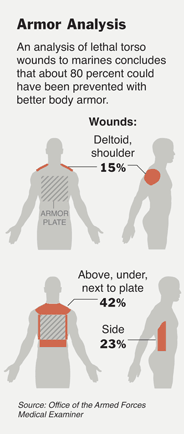
Let's DO SOMETHING ABOUT THIS.
Was there a better way?
This is what happens when you fight urban terrorists without light tracked AFVs.
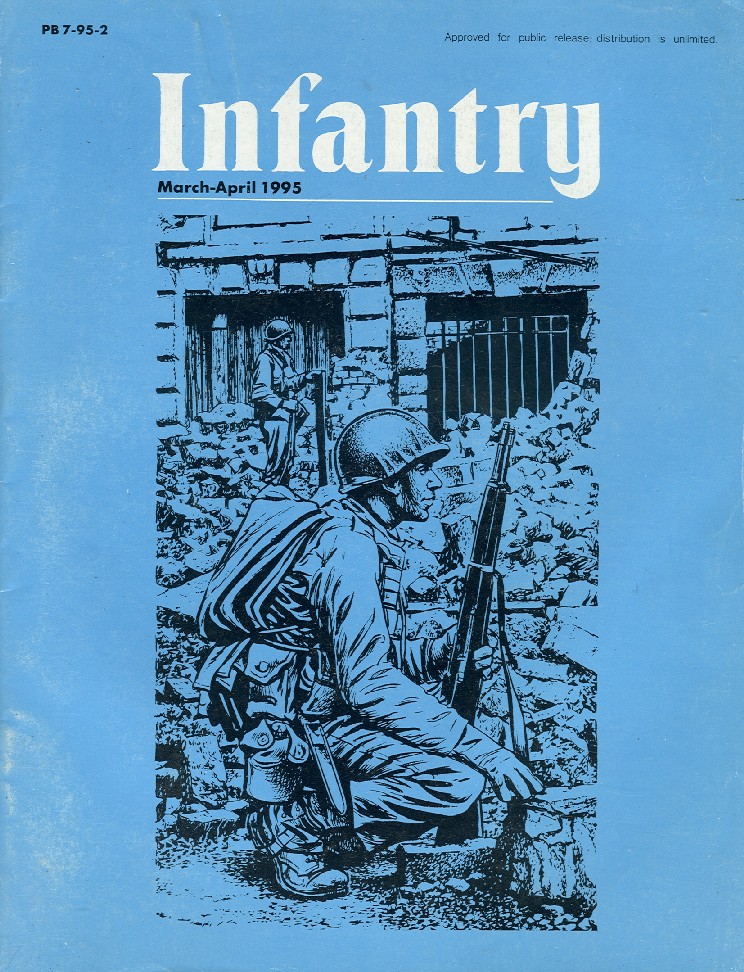
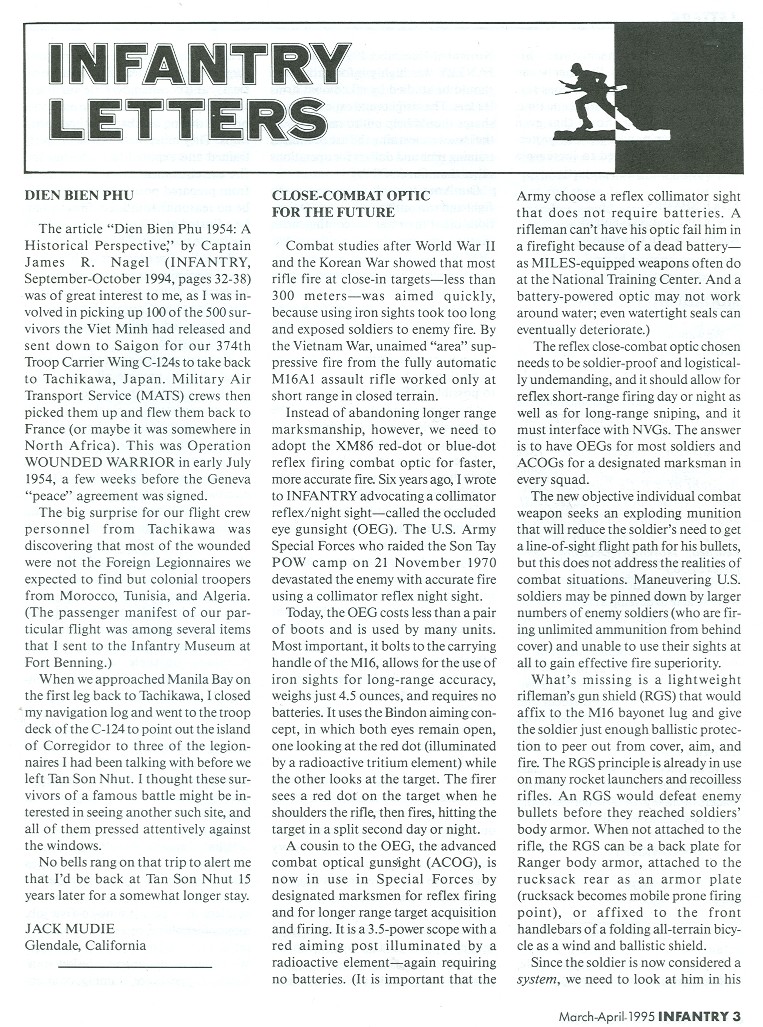

Blackhawk Down!
Movie clip #2
Movie clip #1
"Blackhawk Down": Leave No Man or Armor Behind?
I
"Blackhawk Down" was the day's rallying cry,
Leave no man or armor behind unless we ALL die,
Nineteen brave men lost their lives that day.
That we may live in freedom, each in our own special way.
There were Rangers, Delta, Mountaineers and Aviators, too.
They fought for each other, the way heroes always do.
They took on the mission, which came from on high.
They came in low---but without armor that October 3, sky.
Things went wrong from the very beginning.
Trucks and Humvees were burnt, the omen was telling.
Shots rang out from every woman, child and man.
Then came the words "Blackhawk Down" and the killing began.
They fired back for hours to protect their dead and wounded,
They fought for each other; but the enemy bullets resounded.
They kept the faith, so when the armor finally came they were relieved.
Many walked out so their wounded brothers could be retrieved.
"Blackhawk Down", was it the end of the show?
Would they recover and perform again and where would they go?
They are fighting today in Afghanistan as I pen this short rhyme.
Rangers still have no tracked armor, though M113A3s are ready and we've had plenty of time
If "Blackhawk Down" is the warning, why is armor left behind?
If not convinced about the lethality of the modern, automatic weapons fire-swept battlefield, read the accounts of Israeli Defense Force (IDF) Paratroopers fighting against automatic weapons fire in southern Lebanon:
http://www.israelwire.com/New/990224/99022425.html
We no longer "own" CQB Techniques: Al Queda Terrorists can shoot
We no longer can expect to "own" the edge in shooting techniques over the bad guys and must develop an additional advantage; THE GUNSHIELD.
We also no longer "own" the night, the bad guys have night vision devices, too. We need infared camouflage in addition to gunshields; details: Full Spectrum Camouflage Needed
The following report on al Queda terrorist CQB skills comes from:
Frank Spezzano, Jr.
Cen-Dex Corp.
www.cen-dex.com
P.O. Box 2368
Prescott, AZ 86302
928-443-1513 phone
928-443-0174 fax
Pass this on to those who need to read it.
MFT
I recently had the opportunity to conduct a detailed review of a captured Al Qaeda training tape.
My impressions:
The tape was apparently produced for Al Qaeda internal use and did not appear to be an external propaganda production.
The tape showed Al Qaeda operatives engaging in a number of training exercises including small arms firing ranges, live-fire room entry, and numerous mixed live-fire/role-player type of scenarios.
Scenarios included: Assassinations, Kidnappings, Bombings, and Small unit raids on various types of targets. The training depicted in these scenarios was clearly for export according to an intelligence expert that commented on the tape. "None of these training scenarios depicts the type of fighting that Al Qaeda engages in within Afghanistan."
Detailed planning, diagramming and walk-through's followed by live-fire exercises were the norm.
There were a lot of role playing, scenario type of interactions.
The role players made aggressive moves simulating resistance at various points throughout the scenarios. All such resistance was met with immediate and brutal countermeasures by the terrorists. There was no presumed compliance on the part of the terrorists.
The effort to produce detail and realism in training was impressive.
These people are using extremely effective training methods!
The following points were seen REPEATEDLY and ROUTINELY throughout the training exercises:
1. Use of standard military small unit tactics with multiple elements. (Assault, Security and Support elements)
2. Coordination with sub-elements via hand-held FM radios.
3. Use of pick-up trucks by the assault element to conduct raids/assassinations (shooters concealed in bed of truck).
4. Use of Motorcycles by the security element (as well as in the historical role as a shooting platform for drive by shootings/assassinations.)
5. Use of explosives upon withdrawal from the objective.
6. Use of vehicle horn to signal withdrawal (and initiation of explosives.)
7. Detailed planning and rehearsal of all actions.
8. Exercise of prisoner handling procedures. >From initial contact, to search and control, to execution of prisoners. Role players could be heard begging not to be killed (IN ENGLISH). Terrorists practiced commands in English also.
9. Multiple man room entries. Typically one or two, 2-man teams that assumed a back to back position near the center of the room.
10. Distraction devices used prior to room entry. Fuse lit devices (improvised?)
11. Multiple breach points into structures and into individual rooms.
12. All scenarios were practiced live-fire. Including those that involved role players. Paper targets and role players were interspersed in the same scenarios. (The terrorists showed good muzzle awareness and control.)
The weapons handling was NOT haphazard. All terrorist operatives carried and fired their weapons using the same techniques.
Some specific weapons handling idiosyncrasies are:
1. Handguns were carried in high ready.
2. Long guns (AK variants) were carried and fired rotated 90 degrees (ejection port up)
Specific scenarios included:
1. Targeting of law enforcement officers in ambush/assassinations.
Faked disabled vehicle with shooters concealed in trunk of car or bed of truck. When officer stops his vehicle behind "disabled vehicle" assault is initiated by driver blowing horn. Target was first engaged with rifle fire from the vehicle, terrorists then debussed to administer "coup de grace" at close range. An explosive device was thrown into the LE vehicle on exfiltration. This was one of a number of scenarios that were shown first as a diagram and explanation, then progressing to dry fire walk through and finally to a live-fire exercise. Target location was shown as a 6 lane divided highway with the terrorist vehicle located just prior to the exit/cloverleaf (to allow multiple exfiltration routes and security overview.) There aren't any such highways in Afghanistan and damn few in the Middle East. In one iteration of this scenario the security/overwatch element was exercised firing on possible responding LEOs.
2. Residential assassination.
Innocuous looking person (weapon concealed) knocks on door of residence. Stands in view of peephole and answers question from resident through closed door. When resident opens door terrorist draws and fires, emptying weapon into victim.
3. Assassination on golf course.
Target was on the green (at the pin/flag.) A Rocket Propelled Grenade (RPG) was fired at a vehicle adjacent to the green (VIP security element?) to initiate the hit. Target was then engaged with rifle fire.
4. Two and four-man live-fire room entry (2-man back to back technique) with target discrimination (shoot/no shoot targets).
5. Raid on compound (Kidnapping).
One person taken. Initiated with RPG. Initiation was when Guard Shack was taken out with grenades. Primary target building was engaged with RPG. Primary target building was entered through multiple breach points (through explosive breach of wall and through windows.) Exfiltration was by truck with motorcycle security element in overwatch positions.
6. Drive up kidnapping of target walking down the street.
7. Use of tunnels/storm drains/sewers for infiltration and exfiltration during raids.
8. Rappelling from roof of building to make entry on upper floors was shown on more than one occasion.
9. Motorcycle drive-by target practice. Shooter stands up on rear pegs and extends arms over driver. Excellent muzzle awareness and control.
10. Grenades thrown into second story windows by motorcycle drive-bys.
MULTIPLE SCENARIOS/EXERCISES involved raids on buildings with a large number of occupants (school or office building?)
These raids followed a standard pattern:
1. Covert/surreptitious entry into building and movement to initial points. (Rifles hidden on persons and in bags/cases carried into building.)
2. Initiation with extreme violence of action. Any resisters are shot.
3. Immediate positive control and search of prisoners. Any resisters, or anyone they don't like the look of, are shot.
4. Segregation of prisoners into manageable groups. (Explosives were displayed to gain psychological dominance over prisoners.)
5. Movement of selected prisoners in small groups to the roof where terrorists posture and make statements for the press/cameras.
6. Prisoners executed one-by-one in front of the press/cameras.
7. All scenarios involving prisoners ended in execution of the prisoners and none included a plan for exfiltration of the terrorists. They plan to kill the prisoners and to die in place.
The major take home lesson here is that although the enemy is known to be seeking the ability and opportunity to use weapons of mass destruction and of an unconventional nature, such as hijacked airliners, they are also spending a lot of time training to carry out attacks the old-fashioned way. Attacks executed by small groups of dedicated personnel equipped with little more than small arms.
There is information to the effect that the "perfect day" as seen by Al Qaeda would combine attacks designed to produce the maximum number of casualties with attacks that would give them the opportunity to get "face time" on the news channels to deliver their rhetoric. For maximum effect these attacks would take place nearly simultaneously at multiple geographically separate locations.
We need to address, in training and in personal preparation, the differences between a typical criminal victimization and a terrorist incident in terms of early recognition and appropriate response. I.E. The typical bank robbery vs. finding yourself in the middle of a terrorist attack on a "financial institution" (as per the recent FBI warning.)
If you find yourself in the middle of one of these attacks, there will not be time for the SWAT team to intervene on your behalf. Compliance will buy you only a very little time. If you are identified as a potential problem to the terrorists you will be shot! (They are training to spot Law Enforcement, Security and Corrections Officers as well as armed citizens.) If, by feigned compliance, you make it through the first cut you can expect to be physically restrained and then controlled with threats to the rest of your group and to the other groups. "We will blow up the women and children in the next room if any of you do not do exactly as we say!" Your ultimate fate, if you do not resist, is to be ritually executed in front of the television cameras.
In my opinion the best time to act is most likely to be at the initiation of the attack. Once the terrorists are consolidating on the objective it will be very difficult to take effective action. You must plan on providing effective resistance at the first opportunity! Shoot, move and communicate. Seek cover, use your weapon as required. Attempt to acquire a better weapon system at the first opportunity (do you know how to place an AK into operation?)
Keep in mind that before any terrorist action there are many opportunities to interrupt their cycle by detecting their pre-mission activities. This is where we all can be of assistance. Pay attention to what is going on around you as you go about your daily business. Investigate and report any unusual or suspicious activity that you observe (note vehicle make and model, license plates, personnel descriptions etc.)
John Holschen
Insights Training Center, Inc
From Mike Hargreaves, Brit Special Ops and world-class trainer. I agree with everything except his advice to get rid of those "big bullets." Can't help it, must be in my genes! ;=)
Dave,
Please note in the attack on the kindergarten, the terminology, "gave chase, and killed him with gunshots" no one spoke of arrest, no one said "alleged" "focus" 100% focus, to kill, the only solution, give chase, running, firing whilst running, both hands up, gun bouncing, terrorist hit, turning, trying to fire back, falling, shooter continuing to shoot, terrorist on the ground, he is still being shot!! the pistol was a Semi auto, must have been, probably a 9mm, the gun was in all probability emptied into the head of the terrorist, blood would be on the shoes and pant legs of this children's defender!! America! are you up to this? no you are not! you are too bloody nice! too soft!! these people know this!! this same scenario has been played before in Israel, many times, take it to the RANGE Run, gun up, shoot as you approach targets strung out in line in front of the shooter, end with a ground target, a melon, a squash, whatever, shoot the gun dry, scream like a mad person, reload, seek out hidden targets!!
WEAPON SELECTION. Hicap magazines, 9mm, at least one spare Magazine on belt, two better, night sights.
Ammo: good hollow points in pistol, and first replacement Mag: last Mag: of the three. mil: spec: hardball.
HOLSTER. On belt concealed, always, in house, in office, in Cafe, in Church, always!! you cannot drink to excess, ever again, you dress armed, you think armed, you go armed, always.
Lose the love affair with "Big Bullets" you need lots of bullets,you need the lightest effective round, least possible recoil, hits count, misses with any calibre do not!! cancel the ban on hicap magazines, all concealed carry courses must have live fire, must teach shooting from chair, car, ladder!, where ever you can be.
GET READY AMERICA, OR GET DEAD.
MIKE HARGREAVES.
Men-against-fire is a daily occurrence for the IDF.
And they have both uparmored M113A3 Gavins and gunshields.
A German warfare history expert, LastDingo@gmx.de writes that the German elite Special Forces unit, KSK uses a small gunshield for its point elements to have hard ballistic protection:
"Hello, I've seen 1st TSG advocating shields in several articles, and just wanted to tell you that some of the few official KSK (german special forces) photos show a KSK squad with one shield of approx. 60x40mm here are two of the three published photos with the shield;
www.hkpro.com/hkaction.htm
The third is in the 2/2002 issue of "Soldat und Technik";
www.soldat-und-technik.de/
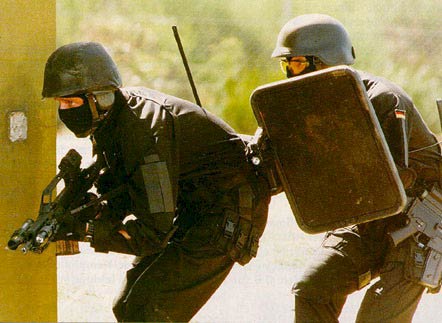
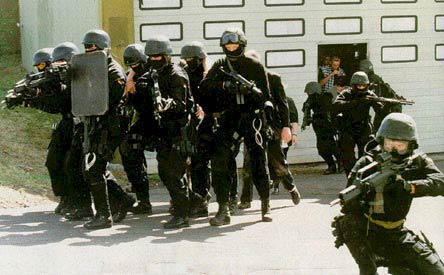
"M16 versus AK47" firefights
Until Somalia, it had been a long time since U.S. Soldiers have been in an assult rifle versus assault rifle firefight, victories in Grenada and Panama were won by U.S. Army Soldiers on the ground, capturing enemy leaders and restoring lawful government without massive USAF fighter-bomber airstrikes. Yet all of the "fire superiority" automatic weapons ethos learned in Vietnam has all but forgotten as America tries to avoid ground maneuver combat and casualties altogether by using digitally guided, stand-off air strike firepower. That victory has eluded us as the Republican Guard's masters and Taliban/Al Queda terrorists have been able to escape shows that we MUST find a way to ground maneuver and not take heavy casualties because air strikes alone cannot win wars.
We can do this.
We MUST do this.
But to do this, the men-against-fire paradigm must change.
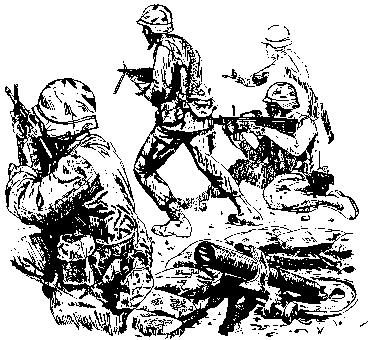
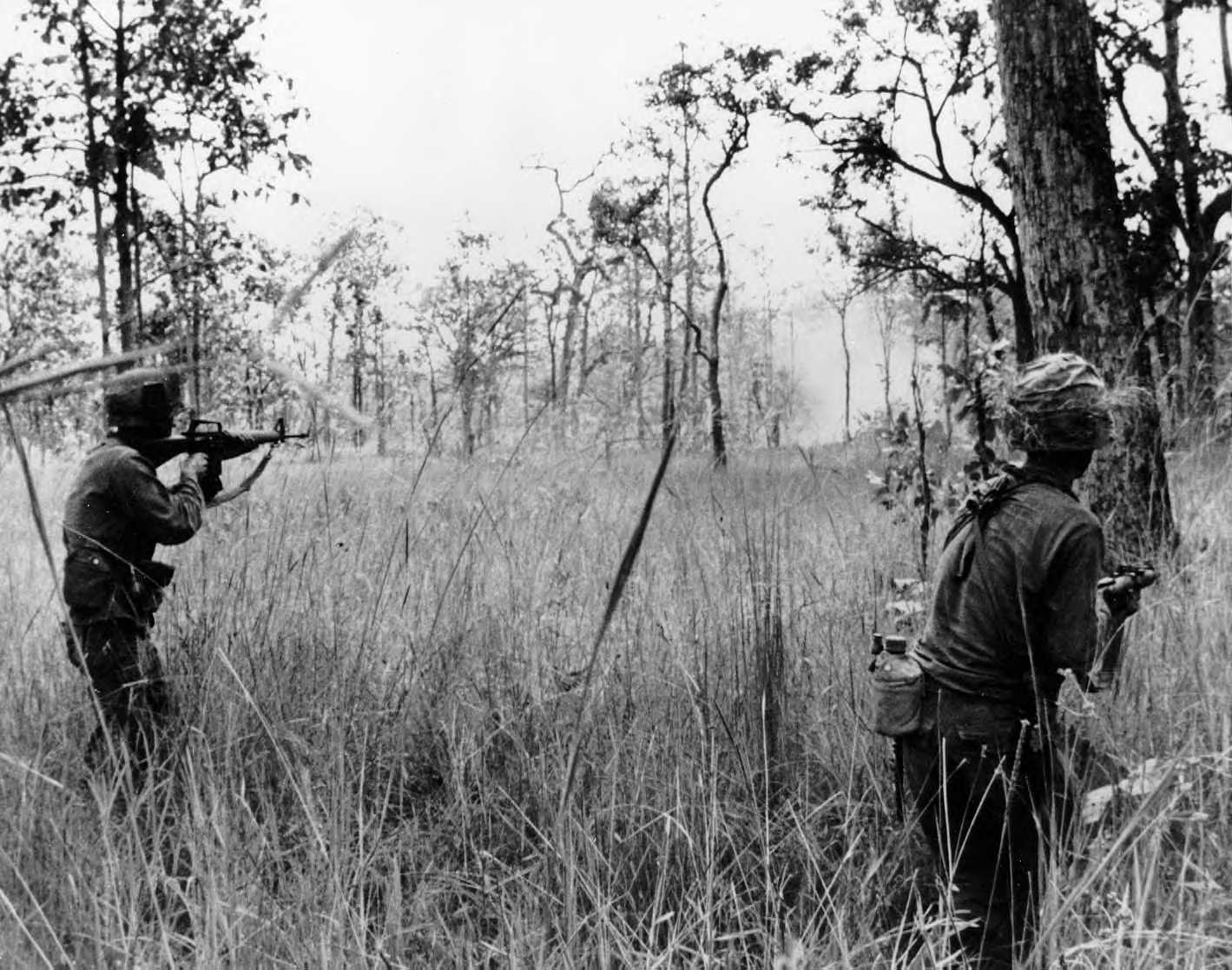
We MUST have a SOLUTION---a shield to protect infantrymen so they can maneuver.

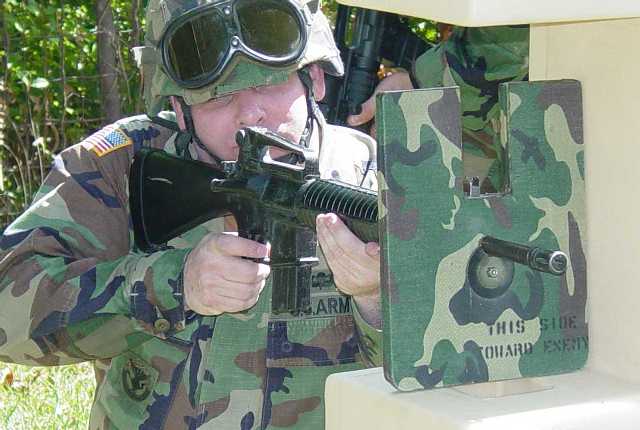
The reality of today's increasingly urbanized battlefield is that heavily defended, high-value targets are going to be covered by enemy fire. If its important enough for us to take it, its important enough for him to defend it. Units that are to spearhead other units need both shock action and armor protection to prevail without heavy casualties. While rifle-caliber resistant Ranger Body Armor (RBA) with hard chest plates saved many lives in Mogadishu, it did not armor protect enough to enable Rangers/Delta Soldiers to move in the face of enemy fire, so allied Army light armored fighting vehicles (AFVs) had to be brought in to extract TF Ranger. Yet 10 years later the 75th Ranger Regiment still doesn't have any easily available M113A3 Gavins with ACAV-style gunshields, or has even put gunshields on their HMMWVs to protect their exposed Gunners!

Studying the October 3, 1993 Somali firefight and the many battles of WWII, Korea and Vietnam its painfully clear that men advancing against enemy automatic weapons fire need more than U.S. Army Brigadier General S.L.A Marshall's fire & maneuver tactics. For years we have thought that good tactics would be enough---documents like SLAM's "Vietnam Primer" written with young Colonel David Hackworth would be enough, but clearly America has been nearly completely seduced by airstrike firepower fantasies and has given up on ground MANEUVER out of fear of casualties. Without maneuver, wars cannot be won, as our enemies increasingly aware of our firepower fetish easily avoid it because we do not take control of the ground from them. We must have a solution to men being pinned by enemy fire to regain maneuver, we must not accept this and the casualties that go along with it----hoping to work around it by another group of men not pinned down. What if there are no men out of enemy contact to do this?

For a vivid description of the effects of enemy automatic weapons fire, read the following account of young Sky Trooper PFC Jack Smith during the battle at LZ X-Ray (see B&W photo above) during the first major American battle of the Vietnam war in 1965:
The American public and even the world seeing the films which makes these truths painfully evident, "Saving Private Ryan", "Band of Brothers" and now "Blackhawk Down!", should be under no illusions about how being "macho" is going to overcome bullets.
We have an idea to save lives and win wars. The invention of 1st Tactical Studies Group (Airborne) Director, Mike Sparks, we have fabricated a 11" by 14" gunshield working prototype that attaches to the end of the M16A2 rifle/M4 carbine via the bayonet lugs to deflect bullets away from the body. This gunshield in modern ballistic-resistant materials would allow us to regain fire superiority and not be pinned down by enemy fire by providing enough cover so we can AIM and fire our weapons without ourselves becoming casualties. Throughout history the most effective way to stop missiles is with a SHIELD away from the human body. Trying to stop them at the chest is unsound and letting bullets get too close in the first place. A shield would protect the arms and exposed areas of the face that are now sacrificed with the body armor-on-the-torso approach. We have contacted the U.S. Army Infantry School urban combat technology team and they want to see a working prototype made of ballistic-resistant materials. [See the 2002 update below]. Perhaps using the:
General Dynmics SURMAX Special Armor for vehicles and ground troops, 7.62mm AP Proof, Multi-Hit, available up to 12.7mm protection????
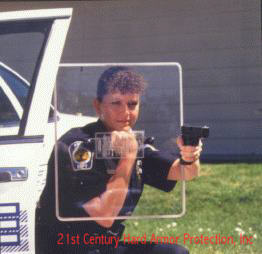
Level III
Model #STL-2100
This insert weighs approximately 5.4 lbs. and is NIJ certified as stand alone against 7.62mm x 51mm Full Metal Jacket, 158 grain M80 Ball round (.308 Winchester) with minimum velocity of 2750 fps.
For a fast upgrade, you can throw the optional carrier over your vest. Or, if your tactical vest has 10" x 12" pockets, then our inserts should fit inside your existing pockets
In fact, look at the clear hand shield with the officer pointing a pistol in conjunction with it? How about attached to the service rifle?
The IDF Special Operations web site has an excellent web page on the IDF Ceramic Shield which states:
In May 1996, in just two days of brutal clashes with Palestinian security forces, the Israeli Defense Force (IDF) lost over 20 Soldiers. One of the primary reasons for this gruesome number was the IDF failure to supply its troops with modern bulletproof protection.
The IDF Soldiers in the May 1996 incident were issued the standard IDF setup - a non-bulletproof Ephod combat webbing worn over a Kevlar flack jacket. However, the IDF flack jacket is based on old U.S. Vietnam era design which provides only basic fragmentation protection.
Since providing all Soldiers with new ceramic vests was a long and an expensive project, after the May 1996 incident the IDF began designing a new portable ceramic shield that will fill the gap until all Soldiers will be issued ceramic vest which can stop high caliber rounds.
The ceramic shield entered service in 2000 in both the IDF and the Israeli civilian security organizations (Border Guard and Police), and since then it has been responsible for saving dozens of IDF Soldiers' lives in the 2000-2001 Israeli-Palestinian clashes.
The shield is made in Israel by Palsan Sasa and cost $5000. It's made of two level 3 ceramic plates each weighting 20 kg, which can stop most handguns, Sub Machine Gun (SMG) and rifles rounds up to 7.62mm X 39mm caliber. At some ranges the shield can also stop 7.62mm X 51mm NATO [Medium] Machine Gun (MMG) and sniper rounds.
The shield's two plates can be used separately or connected to each other. While the plates are connected the shield can stand on its own. However, while the plates are used separately each plates requires support in order to stand. Each plate has few half circle shapes shooting holes in its sides to place the protected person firearm. The shield also come with harness allowing a Soldier to carry the shield folded.
All following photos were taken during the Israeli-Palestinian clashes 2000-2001.
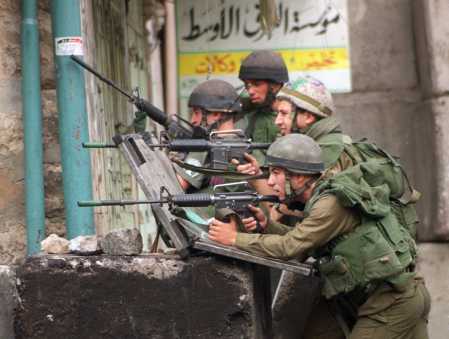

gunshield#3
gunshield#4
gunshield#5
gunshield#6
Excellent photos courtesy of www.isayeret.com
Unique backpack opens to a lightweight shield.
* Provides ballistic protection against artillery fragments from three directions.
* Weighs 4.9 kg and has three panels with a total area of 0.5m2. Flexible assembly.
They also have a Ballistic Foxhole Cover:
* Weighs 13 kg
* Provides two infantry Soldiers protection against artillery fragments in the foxhole or sniper position
The point is that the IDF because its shielded is able to employ ground MANEUVER to take ground from the enemy, and then search for intelligence items as well as capture and KILL terrorists BEFORE they strike. In contrast, the U.S. light, 3D rapid-deployable infantry is unshielded and decision makers are afraid to employ them on the ground to be the "anvil" to airstrike "hammers" and the enemy simply escapes across the border of places like Kuwait/Iraq, Kosovo/Serbia, Afghanistan/Pakistan and now Iraq/Syria. To win the war on terrorism we need GROUND MANEUVER not just stand-off firepower---to do maneuver right we need gunshields, on vehicles and the weapons our men carry.
WHAT IS THE MENTAL BLOCK HERE?
If there is a WILL, there is a WAY.
If they like it, they will buy a small number and test them in their combat cities using paintballs and laser simulators. When they see the lives saved, battles won possible by this advantage, this could result in a mass production order from the U.S. military.
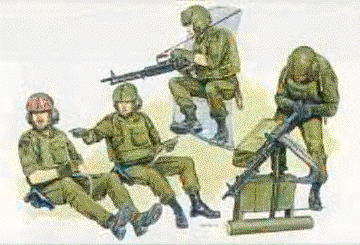
General Dynmics engineers, a long time ago [30 years or more!], examined that concept for application to the heavy M14 main battle rifle firing the 7.62mm x 51mm NATO cartridge still used today in Medium Machine Guns and sniper rifles. A ceramic armor shield similar to that available to helicopter crews (chickenplate) was affixed around the front of the rifle bipod (the M14 had a bipod that could be clipped on just under the gas tube). The armor plates were configured in different sizes and shapes, with the average being about 14 x 12 inches and about 3 pounds in weight.
The results of the trials are as follows:
Defensive Operations
- restricted field of view around the gunshield [we can resolve this using new transparent armor composites that weren't available back then]
- gunshield made the weapon harder to reposition within an already tight defensive position
- gunshield did give the Soldier an added sense of security in a hasty fighting position
- added weight and mass of the gunshield tremendously increases the stability and accuracy of the weapon [acts like a bipod---if we are willing to accept the weight of a 2 pound bipod, why not a 3 pound gunshield that not only acts as a firing position aid but also as a shield?]
Offensive Operations
- gunshield adds too much weight to the weapon, and is of little value when executing 3-second rushes [Ridiculous. A gunshield protects the torso just as much as a plate at the chest on body armor].
- gunshield makes the weapon harder to handle when "shooting from the hip" [We solve this with the Army standard M16/M4 modular weapons system vertical foregrip]
- added weight and mass of the gunshield tremendously increases the stability and accuracy of the weapon
Universally, combat troops [Vietnam Era] thought that although the concept had merit, it was not practical to increase the Soldier's burden to accept the added protection that a personal gunshield afforded. The decision was made, instead, to invest in improving personal body armor as the solution to increasing the ballistic protection of ground troops.
WHAT UTTER BALONEY!
Adding dead weight at the chest is the same burden as weight on the rifle! You simply sling your M16/M4 Rifle/carbine over your shoulder and let the sling carry the weight of the weapon/gunshield when not on high state of alert with weapon in shoulder pocket, at the ready...
Will this be heavy to carry?
YES.
But why lift dead weight for no purpose in the gym when you could "buff" up your arms for something that provides a practical, combat capability--an edge over the enemy?
What works better?
After 5 decades of dead and wounded with the body armor approach its high time we find a better way. It works better to DEFLECT bullets AWAY from the body in the first place.
Funny how its AOK to add 3-5 pounds of sexy night vision gadgets but when it comes to SAVING SOLDIER lives a gunshield is "too heavy".
Interesting, huh?
Let's not be hypocritical and play "favorites". We add 3-7 pound night vision devices to the rifle now, and its "OK" because its a "high-tech" MENTAL gizmo and goes along with our Tofflerian world-view lust to consider anything physical as passe' and "2nd Wave".
What do these mental night vision devices do for the Soldier during the daytime?
DEAD WEIGHT.
Surely, we can add 3 pounds to deflect bullets and PREVENT body injury in the first place.
We must stop living in the fantasy that because we have high-tech mental gizmos that we somehow no longer live in a PHYSICAL WORLD where mechanical advantage--firepower, mobility and protection are still needed. We cannot "mouse-click" our way out of firefights any more than we can "mouse-click" firepower to win wars that require our on-scene presence to do maneuver to take the ground and control governments and peoples.
In contrast to the heavy M14s used in the Vietnam-era gunshield tests, we have the lighter M16/M4 5.56mm x 45mm rifle/carbine now, more advanced materials, excellent shoulder slings and are out of the "Jungle Fighting" mentality---that this concept can be and must be re-examined and perfected.
IF THERE IS A WILL THERE IS A WAY.
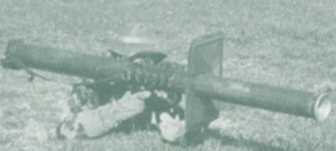
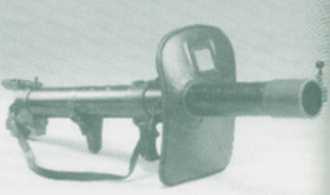
SWISS BICYCLE TROOPS USE A ROCKET LAUNCHER WITH A GUNSHIELD
RUSSIAN MEDIUM MACHINE GUN WITH GUNSHIELD
Even though there is a long history of successful gunshield use on medium and large machine guns, field artillery and rocket launchers, the majority of investment, however, remains with body armor and not personal shields which is a mistake. It is a lot easier for a troop to lay down a shield in front of him than it is for him to take off a set of body armor.
While GD is working with DARPA, the FBI, Second Chance, and the National Institute of Justice (NIJ) to develop a High-Risk Threat flexible body armor based on Surmax(c) (Developed by the Israelis and licensed to General Dynamics). The Israelis are putting it on EVERYTHING because it is lighter, flexible, has better multi-hit capability (it withstands multiple hits where the shots are close together), and it is REPAIRABLE IN THE FIELD. It is also a lot more affordable than composites or ceramics. The U.S. Army Research Laboratory (ARL) are researching advanced clear ceramics like ALON that could be used for a gunshield. Email Mr. Pete Dehmer pdehmer@arl.mil and tell him why we need gunshields NOW. Depite all of this progress, the mental mindset is to use slightly better materials on the same applications---result is no real solution to the men-against-fire problem.
PEACEKEEPING: From Peace--->War in less than 10 seconds
BAGHDAD, Iraq (June 7) - An American Soldier was killed and four companions wounded Saturday in an attack near Saddam Hussein's hometown of Tikrit north of the capital, a military statement said.
It was at least the seventh U.S. Soldier killed in attacks in Iraq over the past two weeks.
Gunmen opened fire on the troops using small arms and a rocket-propelled grenade, said the brief statement released by U.S. Central Command.
The injured troops were evacuated by helicopter and ambulance to medical facilities in the area, the statement said. The names of the Soldiers and their unit were withheld to allow notification of relatives.
No further details were available.
Tikrit, which remains a sensitive area as American forces try to keep a fragile peace in postwar Iraq, is located about 120 miles north of Baghdad.
Dozens of U.S. Soldiers have been killed or injured in a spate of attacks in central Iraq since the end of the war nearly two months ago.
Of particular volatility is the area around Fallujah, a Sunni Muslim stronghold about 30 miles west of Baghdad. More than 1,500 U.S. Army Solders from the 3rd Infantry Division were added to that area last week to prevent unrest and quell attacks on U.S. troops.
Meanwhile, one U.S. Soldier died and two were wounded Friday in a road accident about 20 miles north of Baghdad.
A military statement said they were providing security escort to Coalition Provisional Authority personnel at the time of the accident. The wounded Soldiers were evacuated to a field hospital for treatment.
AP-NY-06-07-03 0915EDT
http://story.news.yahoo.com/news?tmpl=story&u=/ap/20030608/ap_on_re_mi_ea/israel_palestinians&cid=540&ncid=716
Middle East - AP
4 Israelis Killed at Army Post Shooting
45 minutes ago
By IBRAHIM HAZBOUN, Associated Press Writer
GAZA CITY, Gaza Strip - Three Palestinians disguised as Israeli military sneaked into an army post Sunday and killed four Soldiers before being killed by troops the first major attack on Israelis since last week's Mideast summit.
The shooting, a possible setback to a U.S.-backed peace plan, came just hours after Palestinian militant groups affirmed they would not halt attacks on Israelis. After the killings, Israel quickly demanded Palestinian officials crack down on militants.
Three armed groups Hamas, Islamic Jihad and the Al Aqsa Martyrs' Brigade claimed joint responsibility for the shooting. A leaflet gave the names of the gunmen, all in their early 20s, one from each group.
"This joint operation was committed to confirm our people's united choice of holy war and resistance until the end of occupation over our land and holy places," the leaflet said.
The attack is a blow to efforts by Palestinian Prime Minister Mahmoud Abbas to persuade militants to halt attacks on Israelis his strategy for bringing a halt to violence as required under the U.S.-backed "road map" for peace.
Hamas pulled out of truce negotiations last week, and the Al Aqsa militia's participation in the shooting poses a direct challenge to Abbas, since the group is linked to his ruling Fatah (news - web sites) movement.
The gunmen, who wore Israeli army uniforms and were armed with assault rifles and grenades, attacked the post near Gaza's Erez crossing into Israel just after dawn, the Israeli military said.
Maj. Gen. Doron Almog, head of the army's southern command, told Israel Radio the attackers arrived by surprise at the northern edge of the post, and killed the four Soldiers, three of them at close range. Four other Soldiers were wounded.
Israel demanded Abbas immediately begin arresting militants, dismantling their organizations and disarming Palestinians.
"If terrorism will continue, it will destroy the road map, it will destroy the peace process," Israeli government spokesman Avi Pazner said.
Abbas said he would resist pressure to crack down on the militants and would continue efforts to talk with them.
"We will not allow anybody to drag us into a civil war," Abbas said Sunday.
Palestinian Foreign Minister Nabil Shaath said Israel provoked the attacks by continuing restrictions on Palestinians and killing two Hamas militants Thursday night near the West Bank city of Tulkarem.
"This requires an immediate discussion with the Palestinian factions to bring an end to the fighting and there is an effort from all sides to make sure that this happens," Shaath said.
The shooting underscored the determination of militants to derail the road map to Mideast peace, which envisions a Palestinian state by 2005.
Abdel Aziz Rantisi, a Hamas leader, said the attack was intended to send a message to the Palestinian leadership that Palestinians will continue to fight Israel and will not "surrender to the pressure exerted by Israel and the United States of America."
"We are unified in the trenches of resistance," he said.
A videotape sent to The Associated Press shows the three attackers wearing army uniforms and sitting in front of the three flags of their militant groups. Three copies of the Quran, two rifles and several hand grenades lay on a table in front of them.
The attack came hours after an armed Palestinian tried to attack a Jewish settlement in Gaza, according to Palestinian and military sources.
Israeli troops killed the man, who was armed with an assault rifle and a pouch of grenades, after he fired at them Saturday night from a house in the central Gaza Strip (news - web sites), military sources said.
The reality in a peacekeeping operation, is that Soldiers will be surrounded by a civilian majority behaving as they were at peace. Amongst this tranquility, terrorists/guerrillas/bad guys will use this civilian "cover and concealment" to get a line-of-sight (LOS) to aim/hit peacekeepers and/or be close enough to throw a hand grenade. In such a situation the bad guys get "the drop" on the good guys by exploiting the peace. They might even wear friendly forces uniforms to get that LOS and close proximity to ambush. The good guys DO NOT get the time to go to ground, employ SLAM fire & maneuver tactics etc. The only protection they have is WHAT THEY HAVE ON RIGHT THEN.
GUNSHIELDS.
We need to place gunshields on the end of peacekeepers as they patrol semi-peaceful areas so that even if terrorists try to ambush them there will be a hard shield IN THE WAY of their intended bullets and/or grenades. By placing a gunshield on the end of peacekeeper's weapons they will passively be placing a wall in front of themselves as they walk, especially if their weapons are slung over their shoulder holdng up the weight of the gunshield.
The U.S. Army's MP HMMWVs now have gunshields...why not our Soldiers?
UPDATE 2003: Meet the S. L. A. Marshall Weapons Gunshield
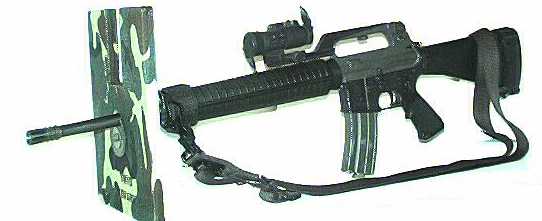
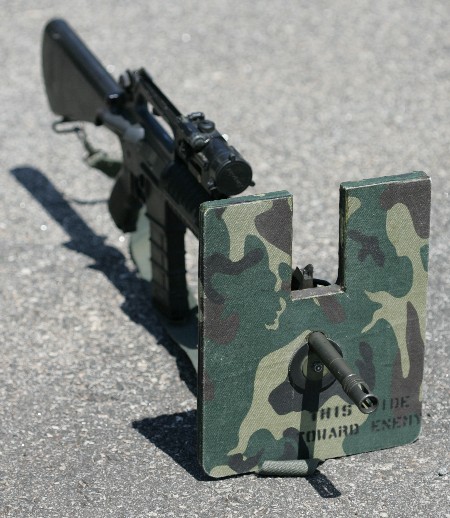
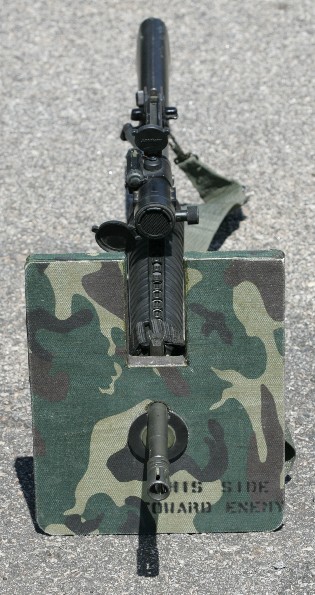
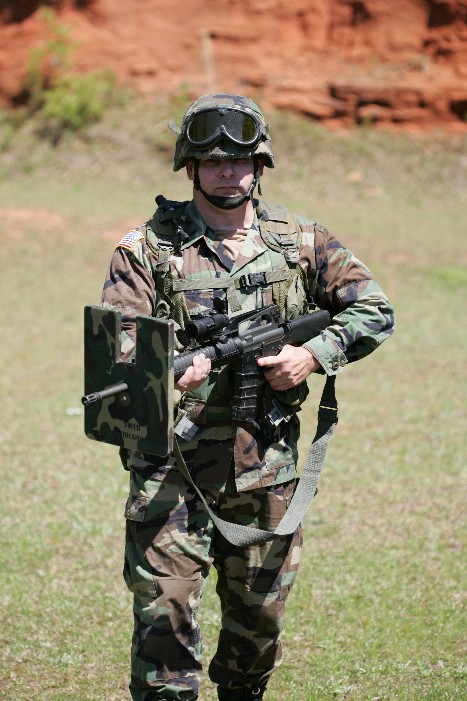
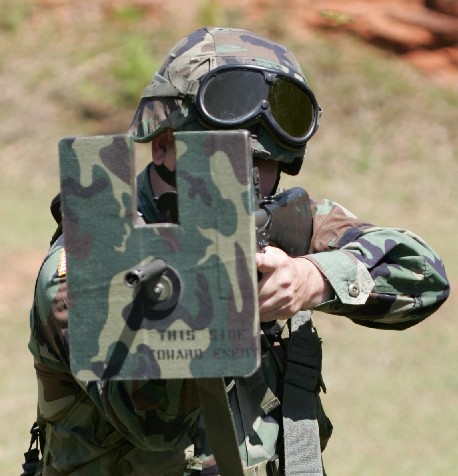
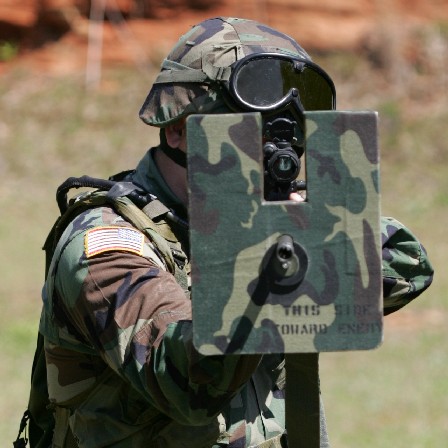
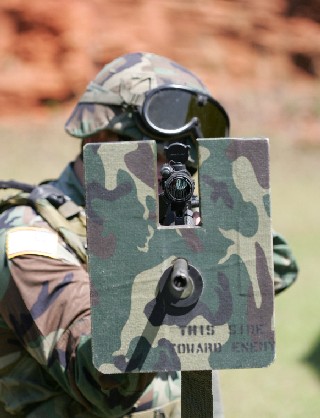

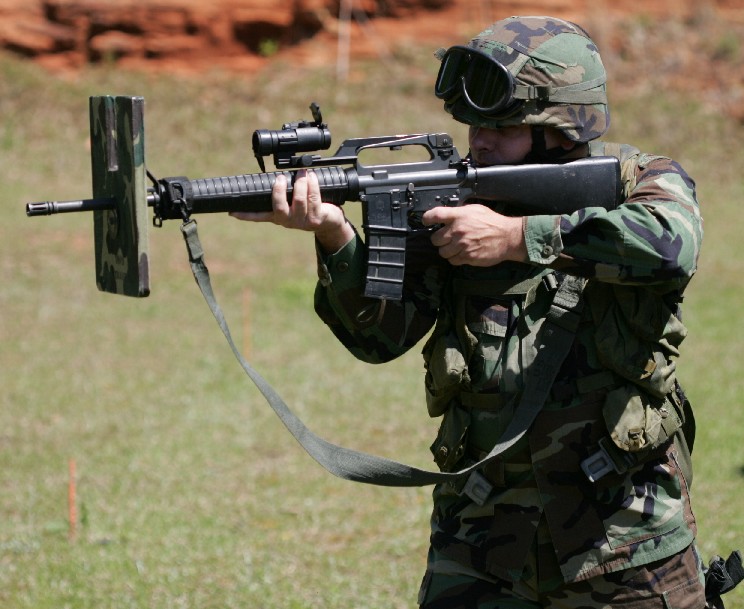
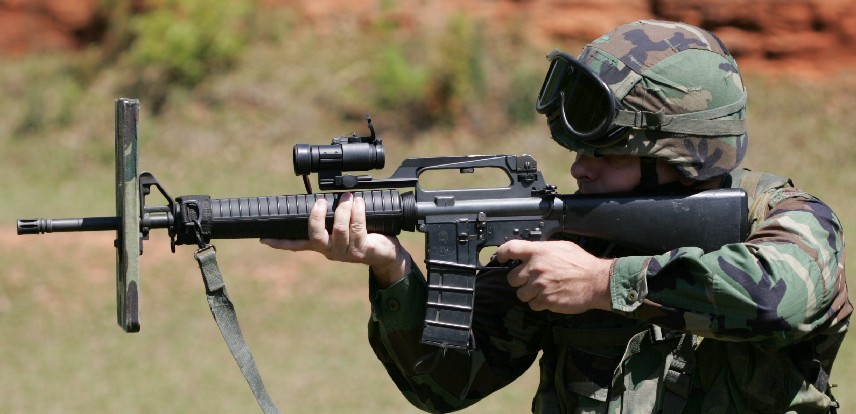
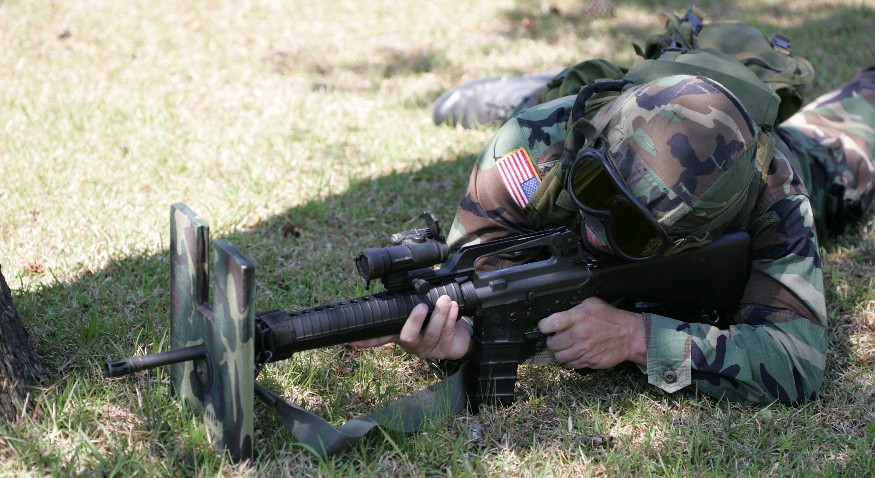
Superb photos by Hans Halberstadt
Thanks to the Simula Company who have courageously donated their time and materials used in their "Interceptor" Body Armor plates, we have a gunshield. The gunshield will stop the impact of three 7.62mm x 39mm "AK47" assault rifle rounds (Army Times story below***). Thanks to the Ontario Knife Company, we have bayonet attachment devices to connect the gunshield to the M16 rifle/M4 carbine bayonet lug. We salute both companies for their defense of freedom and willingness to SOLVE problems to save Soldier lives not just perpetuate the failed status quo.
Bayonet Attachment Device
Ontario Knives
P.O. Box 145
26 Empire St.
Franklinville, N.Y. 14737 USA
PHONE: (716) 676-5527 FAX: (716) 676-5535
Gunshield
Simula Safety Systems International
In honor of his pioneering work detailing the problem of men-against-fire, we call the new M16/M4 weapons gunshield, the "S. L. A. Marshall Weapons Gunshield".
The SLAM Gun Shield gives commanders an option of either wearing it on the body or on the end of Soldier weapons as the situation might warrant.
We will post pictures of the Marshall Gun Shield and provide details of field tests as we go along.
IMITATION IS THE HIGHEST FORM OF GUNNERY
Anyone who saw the 1987 007 movie, "The Living Daylights" would have seen the small, clear gunshield on the end of the villain's weapon in the final shoot-out.
Jimmy Wu found someone who shares our idea of a gunshield at a show in Las Vegas, and adds another way for getting the same protection; he writes:
"The picture below is from this year's SHOT Show in Las Vegas, taken by SMGLee of AR15.com. The relevant post can be seen here:
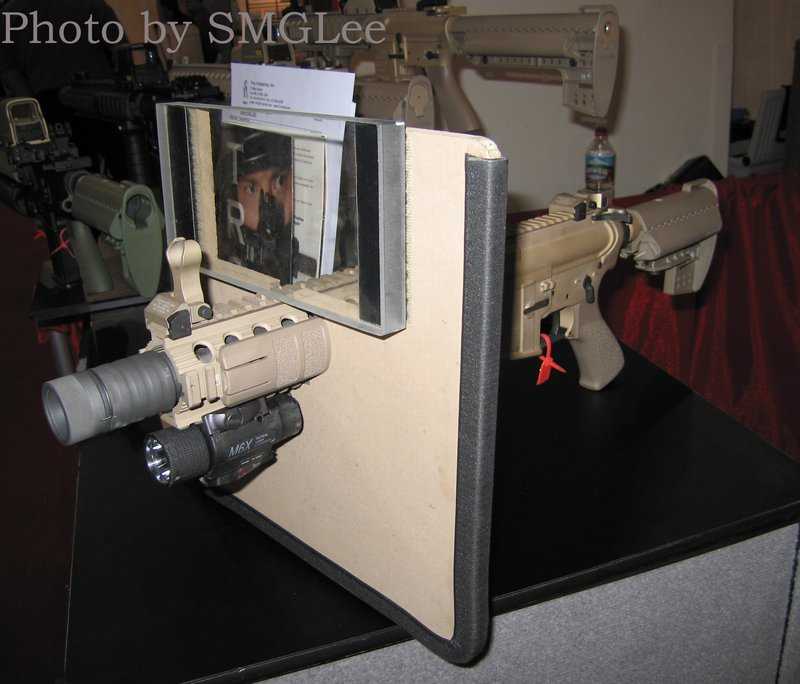
http://ar15.com/forums/topic.html?b=3&f=118&t=268889&page=7
It is a prototype from Troy Industries (www.troyind.com ), a maker of M-16 accessories. It mounts directly to the railed forearm of an M-16. I have not been able to obtain more information from the vendor.
I had been thinking about the gun shield concept, and it'd certainly be nice to have such a product. However, in the meantime, we don't have to wait for a commercial product to hit the market.
Soldiers can easily modify the current SAPI plates into a small forearm shield, to be carried by the non-dominant arm. In this manner, the Soldier does not have to cut into the SAPI plate, potentially compromising its structural integrity. He does not need to wait for vendors to cut a hole in the plate. The Soldier simply needs to bend some aluminum strips into a bracket to hold the plate and arm. Because vertical foregrips are everywhere these days, you have your non-dominant, support arm in a good position to hold the shield anyway."
We wrote to Troy Industries:
-----------------
Forwarded Message:
Subj: FYI, we came up with a rifle gunshield before you did
Date: 4/18/2006 7:22:55 PM Eastern Daylight Time
From: DynmicPara
To: info@troyind.com, DynmicPara
To: xxxxxxxxxxxxxx
Dear Troy,
FYI, myself and SIMULA made a much simpler gunshield over 4 years ago:
www.combatreform.org/gunshield.htm
Obviously, your shield is different than ours because it has a clear view port and is attached farther back around the handguards so its a different design. Your shield:
http://ar15.com/forums/topic.html?b=3&f=118&t=268889&page=7
I'm not interested in who is going to make $ off the gunshield, I'm interested in overcoming the light infantry narcissism that REFUSES TO ADOPT GUNSHIELDS so we can save our troop's lives and win wars.
I would like to discuss the reactions we have gotten so far to help you sell your gunshield to the U.S. military.
Airborne!
Mike Sparks
Here's another copycat of our gunshield...the "LadderShield"...

For firing in the prone...


And of course...as a small assault ladder...
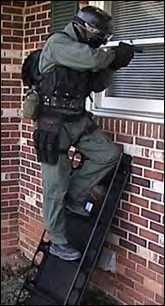
TACTICS, TECHNIQUES AND PROCEDURES USING THE S.L.A. MARSHALL GUNSHIELD
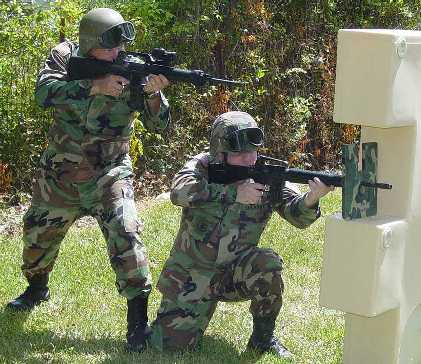

Above is a "buddy team" of Soldiers one with the SLAM gunshield on a "rubber duck" M16 simulates various firing positions from behind a Spirit of America (SOA) earth-filled, modular portable blast wall section.
Get down! Return Fire!
In the opening seconds of an ambush, often the point element Soldiers are the first ones hit by enemy fire even before they can fire back. In Vietnam, pointmen wore extra body armor, and today its standard police SWAT and military hostage rescue unit tactics to have point elements carry full body and smaller shields to replicate a modern-day "phalanx" effect of providing an armored exterior for a formation of men. However, what if the enemy fires upon the main body or what do we do to protect Soldiers in a running gun battle from being hit as they move from firing position to firing position?
Once a Soldier realizes he has a small piece of portable cover attached to his weapon with the SLAM gunshield, he will endeavor to keep it in front of him as he moves and to minimize his body frontal area sticking out behind it. When firing from the prone, almost the entire body can be placed inline behind the SLAM Gunshield to protect against enemy fires. This "shield awareness" is good because it aggressively makes the Soldier point his weapon at the enemy and to encourage him to fire it accurately at him. Current Individual Movement Techniques (IMT) would be enhanced by a SLAM gunshield protecting the Soldier as he high or low crawls and makes brief 3-5 second rushes. Actual force-on-force combats using SIMUNITION or MILES would demonstrate how even a small bit of portable cover can mean the differance between getting hit or not hit during IMT. When not in a high state of alert, the weapon/gunshield would be carried using a good Close Quarters Battle (CQB) sling. If the Soldier's gunshield gets hit by enemy fire, it may force the weapon from his hands. However, the CQB shoulder sling would prevent him from losing his weapon during a critical second during a firefight or having it damaged if it hit the ground.
Airborne!
Mike Sparks
Director
1st Tactical Studies Group (Airborne)
***Army Times
March 4, 2002
Pg. 8
Not So Bulletproof: Troops on the front lines lack vital piece of body armor
By Sean D. Naylor, Times staff writer
KANDAHAR INTERNATIONAL AIRPORT, Afghanistan - As the Kalashnikov rounds rained in on his machine-gun position Feb. 13, Spc. Timothy Bates sheltered himself behind the sandbags, then poked his head up and returned fire with his M4.
"You could hear the rounds popping overhead, you could hear them smacking the sandbags," he said.
Had one of the 7.62mm rounds hit Bates in the chest, his brand-new "Interceptor" body armor was designed to stop it cold.
But it's unlikely that Bates' vest would have stopped the 7.62mm rounds because it was missing critical, potentially life-saving components.
The vests the troops wear are designed to have two, high-tech ceramic plates inserted front and back. Each plate can stop three 7.62mm rounds, according to Bates' battalion commander, Lt. Col. Charles "Chip" Preysler.
Bates and many others in his platoon did not have the ceramic plates during the firefight.
It turns out that the $500 plates are in short supply throughout the Army, even among the men and women thrust onto the front lines in the war against terrorism.
By the time the 101st started shipping troops to Afghanistan, for example, it had received plenty of the $450 vests but only 800 sets of the plates, according to David Nelson, acting product manager-Soldier equipment at Fort Belvor, Va.
According to Maj. Paul Fitzpatrick, spokesman for the 101st, all 800 pairs of plates are in Kandahar. There are 1,700 Soldiers of the 101st's 3rd Brigade in Afghanistan, meaning there are plates for less than half the troops.
Even without the plates, the vests alone still offer roughly the same protection against shrapnel and 9mm ammunition as the [PASGT] flak vests they replace, Preysler said. All of his troops have the vests.
"I'd rather have this [vest] now and have some form of protection against fragmentation," he said.
The problem is simply one of supply, according to 3rd Brigade commander Col. Frank Wiercinski. "We are getting them as they are being produced, and as they are being shipped," he said.
Nelson said, "All of the present production [of plates] is for the 101st." The three companies that make the plates are turning out about 2,500 to 5,000 sets per month, which is all the Army budget allows for, he said.
There is some finger pointing about the apparent shortage. An official at the Pentagon involved in supplying the plates said the 101st had gotten all of the plates it asked for. It requested and got 385 pairs in November, and another request in 417 in December, said the official, who asked not to be quoted by name.
Fitzpatrick said that when the 101st made its initial requests, the number of plates ordered would have been sufficient for the planned number of troops. But, Fitzpatrick said, the mission kept changing and the number of troops got ahead of the supply of bulletproof inserts. Fitzpatrick said that by the end of March, each Soldier in Afghanistan would have a full set of ceramic plates.
Even when the 101st and other Army divisions receive all the ceramic plates the Army plans to buy, it will still be enough to equip only one in every three Soldiers.
"That ratio allows for people likely to go into harm's way to get plates," Nelson said. "One hundred percent of that battalion is not in harm's way at any given time."
Wiercinski pulled out his vest to show that it contained no plates, and added that Soldiers in units like his Headquarters and Headquarters Company and the 626th Forward Support Battalion, who are unlikely to face direct enemy fire, do not have plates either.
Preysler said his aim was to ensure that as many of his troops on the line as possible had at least a front plate. But, he acknowledged, "There may be a few Soldiers that still do not have plates."
Bates, on the front line without the plates, was lucky. The only round to hit him missed what the military likes to euphemistically refer to as "center body mass" and nicked the pinkie on his right hand.
In the meantime, Soldiers going without the added protection will have to display the same fortitude as those who faced withering fire Feb. 13.
Pfc. Will Davis, who was firing the M240 [medium] machine gun next to Bates, said he "didn't even think about" the fact that his vest was missing the plates.
Bates echoed his buddy. "After the fact, I thought about it, and it made me feel a little bit uncomfortable," he said. "But it wasn't an issue at the time."
Another Afghanistan Gear report:
PFC. Jason Ashline recently celebrated his 21st birthday, one he came close to missing. When he was shot March 2, the first day of Operation Anaconda in the cold mountains of Afghanistan's eastern region, the 7.62mm round fired from about 200 meters away bored in about one inch from the edge of his left body armor plate - right near his heart. "It felt like a baseball bat hit me right in the chest full force," he said. "It stunned me, but didn't knock me unconscious." On his back and fully awake, Ashline, of 1st Battalion, 187th Infantry Detachment, 10th Mountain Division, was dragged by his squad leader down a slope to safety. Within minutes, he was up and returning fire. His story and the armor plate still containing the offending round took center stage July 16 and 18 on Capitol Hill when the Soldier Systems Center, the Program Executive Office Soldier and the Aviation and Missile Command joined forces to display their wares for members of Congress. "This is really to let the congressional folks see what the Soldiers are experiencing over in Afghanistan," said Debbie Dawson, a spokeswoman for PEO Soldier. (Excerpt from "Eye-Opener On Capitol Hill," Army Times, p. 4, 29 July 2002, by Gina Cavallaro).
Individual Movement Techniques (IMT) anyone?
U.S. Army might want to teach USMC what IMT is, too!
 www.youtube.com/watch?v=I5d6I4CkqPw
www.youtube.com/watch?v=I5d6I4CkqPw
Lax marines wait to be told what to do during battle drills
Once we have sound IMT and infantry formations with reasonable command and control, this gets us to a slightly improved SLAM's men-against-fire construct...we now need to surpass this with a weapons gunshield...the following is a good article except its "we-are-great-because-we-are-Americans" and relativity over combat casualties BS; to the professional warrior making rationalizations will not do; EXCELLENCE demands we not sit on our laurels but do better. While our casualties may be less than our enemy's they are still TOO HIGH and have resulted in battlefield and public policy defeats regardless.

Washington Times
March 11, 2002
Pg. 16
No 'Buts' About U.S. Military
By Jonah Goldberg
American Soldiers are training allied Afghan troops how to lie down. I don't mean anything figurative or metaphorical. I mean, literally, we're teaching battle-tested Afghan warriors how to lie flat on the ground, as in what you do when you fire your rifle in the prone position.
At first I thought I was missing something. Learning how to shoot from the prone position is one of the first things you learn after basic gun safety. It also seems like common sense; in battle, one of the tricks to surviving is to make yourself as small a target as possible. Heck, even my little green toy Soldiers came with a large contingent of GIs firing from the prone position.
But, after asking some military folks, it turns out that despite decades of nearly constant fighting, the Afghans aren't the best Soldiers in the world. The reluctance to get down on the ground to shoot and be shot at is just a small illustration of that fact.
It turns out that some Afghans feel it is unmanly to shoot from the ground. Others explain they have trained with antiquated weapons that make more sense to fire while standing. But all of them explain their reluctance by saying in their respective tongues, "This is the way we've always done it."
That attitude reveals one of the central reasons American Soldiers are more dangerous than their counterparts. It is a common assumption in certain corners of the globe that because America is free and open and prosperous, its military must also be undisciplined, uneducated and lazy. The reality is exactly the opposite.
The American military, while couched in discipline and tradition, has been reinventing itself and readapting to new challenges since the first American patriots hid behind trees to shoot Redcoats. "But this is the way we've always done it" doesn't fly with us.
As military historian Victor Davis Hanson argues in his wonderful book Carnage and Culture: Landmark Battles in the Rise of Western Power, Western civilization's, and most notably America's, military advantages were never genetic nor geographical, as some have argued. The advantage was, and remains, cultural. Western military success is directly the result, he writes, of "larger social, economic, political, and cultural practices that themselves seemingly have little to do with war."
"It is almost a truism that the chief military worry of a Western army for the past 2,500 years was another Western army," Mr. Hanson concludes. More Greeks died in one battle of the Peloponnesian War, he notes, than in all of the battles with the Persians. The Boers killed more British Soldiers in a week than the Zulus did in a year.
 www.youtube.com/my_playlists?p=F062853121876432
www.youtube.com/my_playlists?p=F062853121876432
Similarly, even when Americans lose battles against non-Western nations, the casualties are notoriously lopsided. In the BlackHawk Down! incident in Mogadishu, the United States lost 18 brave men. The Somalis lost roughly 55 men for each American life lost.
The newly released film "We Were Soldiers" tells the story of the first major (and victorious) battle between the United States and the North Vietnamese in the Ia Drang valley of the Central Highlands of Vietnam with similar casualty ratios. And, of course, 149 Americans were killed in action in Iraq while estimates of Iraqi dead range from 50,000 to 150,000.
We don't know exactly how the battle in the mountains outside Gardez, Afghanistan, will end. But it's a safe bet that we will win and that for each American casualty there will be scores of Taliban or al Qaeda casualties. Already, the United States has lost eight men, while the enemy has lost hundreds.
The Taliban's leaders were fond of telling the press before we bombed them forward into the Stone Age that the United States would meet with ruin once its forces set foot on Afghan soil. Superior technology, they asserted couldn't make up for the basic weakness of the American character. This sort of analysis always puts the cart before the horse. It is the ingenuity and creativity of the American character that made such technology possible in the first place.
Jonah Goldberg is a nationally syndicated columnist.
FEEDBACK!
An Army infantry Captain writes:
"Agree.
Of course you rarely see anyone carrying an e-tool these days. Once we start receiving direct or indirect fire, you'll see troops start to dig in again, every damn time they halt."
Andrew Wyatt writes:
"I recently read your piece on weapon gunshields for m-16's, and I think they're a good idea, but the execution seems a little flawed to me.
Instead of attaching them to the bayonet lug, A better solution would be to utelize the MWS rails on the M16 A3/A4 and M4 carbines as an attachment point. this would allow the soldier to have the gunshield placed farther back on the weapon,which would make the weapon handle better, and allow for a little better field of view through the aiming slit.
Perhaps instead of issuing them to everyone, or just riflemen (this would be incompatable with an m203), perhaps mounting the gunshields on m249's would be a better solution still. the SAW gunners need this protection, too, and arguably more than everyone else does, since they're thought of as more of a threat.
as for the molle equipment being crap, I've had a chance to examine a molle medical backpack (which had a split seam, now that's a surprise)and while the backpack seems well designed, the execution leaves much to be desired. Equipment suppliers like Blackhawk and eagle make far superior gear, and I think that the company that currently makes molle needs to be replaced by someone who can make something that's actually durable.
I say this, because I purchased a Tactical tailor MAV, and i find it to be an outstanding piece of kit, being much more durable than the issue stuff.
as for the design of the vest, Tactical tailor makes their tactical vest design in a molle compatable version, which would most definitely work better.
keep your powder dry."
Jack Sawicki describes the closed-minded stupidity of Infantry Center and School he encountered:
"We came up with the same idea back in 1991 for the Army S.I.P.E. Program but the Infantry School rep laughed at it--and me--and it was thrown out..."
PRIVATE MURPHY'S VIEW
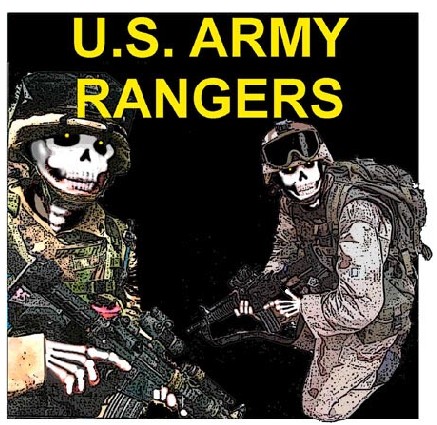
 RETURN TO U.S. ARMY AIRBORNE EQUIPMENT SHOP
RETURN TO U.S. ARMY AIRBORNE EQUIPMENT SHOP

